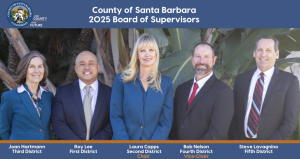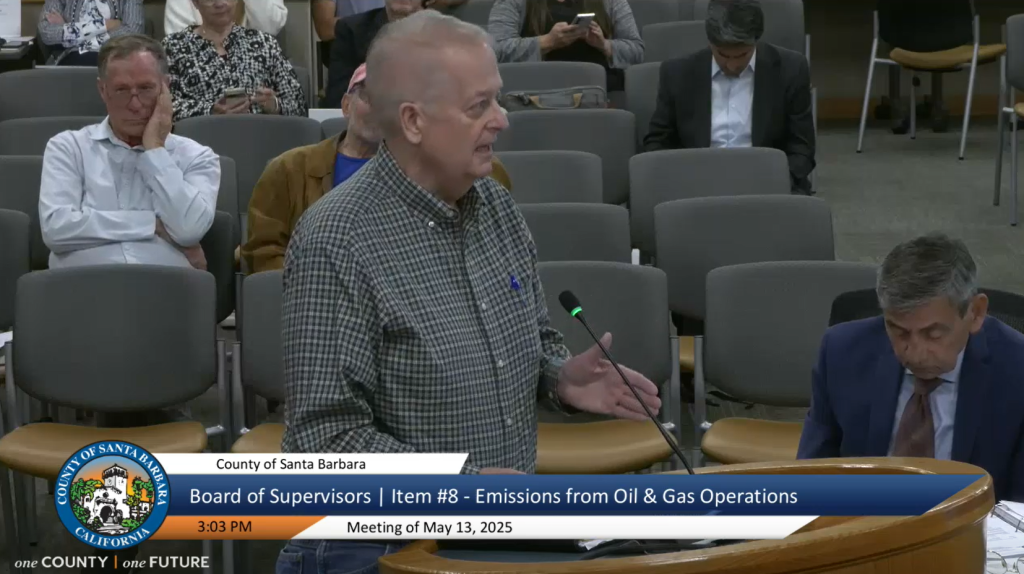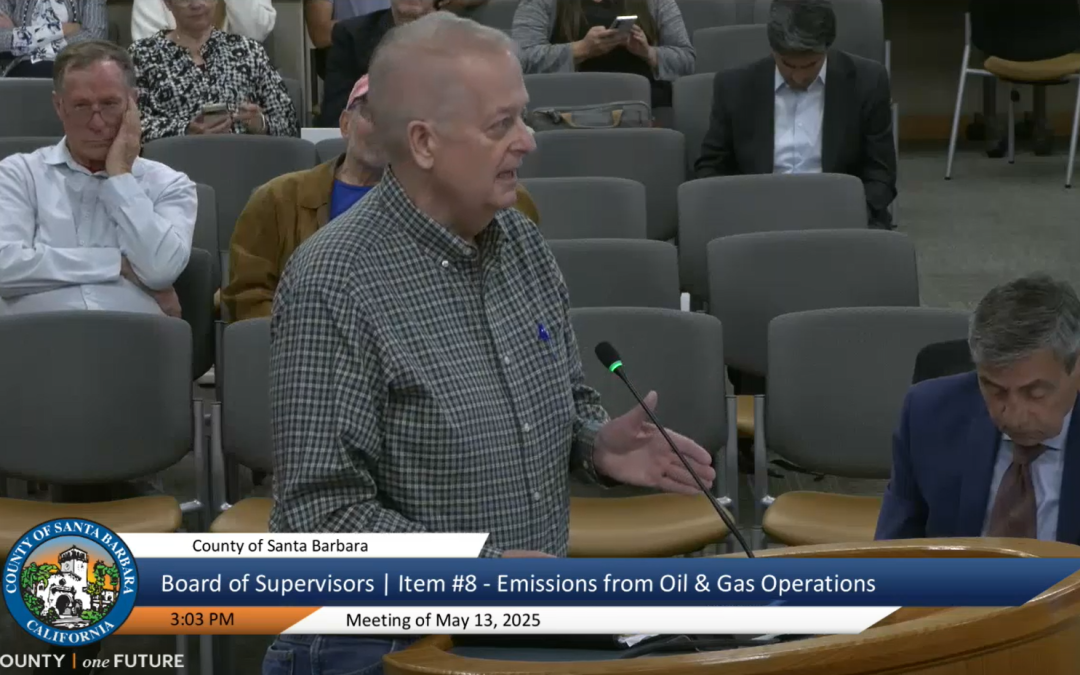Above, NARO-CA President Ed Hazard at the Santa Barbara County Board of Supervisors meeting on May 13, 2025, speaking in opposition to an oil and gas shutdown proposal.
The Santa Barbara County Board of Supervisors voted 3-1 on May 13, 2025, to direct staff to prepare an oil shutdown ordinance by October 2025, despite fierce opposition from 4th District Supervisor Bob Nelson and NARO-CA. The hearing revealed deep procedural concerns, including allegations that South County supervisors (Capps and Hartmann) coordinated behind closed doors to add the shutdown proposal to what was originally just a greenhouse gas inventory item. With 5th District Supervisor Lavagnino absent due to a family emergency, the three anti-oil supervisors pushed through the measure affecting an industry that provides an estimated 1,800 jobs and generates significant economic activity, primarily in Nelson’s North County district.
NARO-CA member and Santa Barbara County royalty owner Roy Reed, in the article below, raises questions about potential Brown Act violations and criticizes the Board’s apparent coordination with environmental groups while excluding industry stakeholders from preliminary discussions.
This article was published in the NARO Royalty Owner Action Report, a monthly newsletter sent to full members of NARO.
ROYALTY OWNERS & OIL INDUSTRY AMBUSHED AT THE SANTA BARBARA COUNTY BOARD OF SUPERVISORS
By Roy Reed, NARO-CA member
The Santa Barbara County Board of Supervisors’ May 13, 2025 hearing was most notable as years of anti-petroleum animus festered and ruptured as the South County three anti oil & gas Supervisors ganged up on 4th District Supervisor Bob Nelson to once again attack the welfare of North County’s petroleum industry and all of those who depend on it.
The genesis of Wednesday’s affair found its roots in the 1969 Santa Barbara Channel oil spill from a Union Oil drilling operation which resulted in the birth of “the modern environmental movement,” as Santa Barbara environmentalists often claim. Through the years, anti-oil sentiment among South County activists grew and culminated in 2014’s Measure P campaign, which along with several other such measures in other counties appeared at the polls in the next year or two. Most notable were Measure P, which was soundly rejected by Santa Barbara County voters, and Measure Z, which passed in Monterey County but was later rejected in the courts as unconstitutional as the result of a lawsuit filed by Chevron, NARO-California, and others. Stung by that defeat, radical environmentalists and their Bay Area law firm crafted AB 3233, which Dawn Addis, a new and undistinguished Assembly member representing a portion of Monterey County, sponsored, and which the radical anti-oil dominated State Assembly passed, and which was later signed by California’s extremist Governor, Gavin Newsom.
AB 3233 was designed as a work-around of the court’s rejection of Monterey County’s Measure Z and attempts to give authority to municipalities and counties to regulate oil and gas extraction in their jurisdictions so long as they are either more restrictive than CalGEM or prohibit oil production entirely. It is the opinion of many well-schooled in the law and in petroleum affairs that AB 3233 shares the same fatal flaws as failed Measure Z which it seeks to replace.
Which brings us to the BOS Hearing of May 13th.
The Agenda Item had been originally scheduled as a decision as to whether or not to add oil and gas production emissions to the County’s greenhouse gas (GHG) inventory. However, as County CEO Miya Miyasato explained, a letter earlier received from Supervisors Laura Capps (2nd District Santa Barbara) and Joan Hartmann (3rd District Santa Ynez Valley-Lompoc) requested that preparation of an oil-shutdown ordinance be added to the item. While that move seemed to be communicated to the County’s environmental community, it was not similarly communicated to either the North County Supervisors Steve Lavagnino (5th District Santa Maria) or Bob Nelson (4th District Orcutt).

The item was introduced by Jesus Armas, Community Services Director, and handed off to Garrett Wong, Sustainability Manager, whose department operates the County’s Climate Action Plan. Wong carefully laid out the various elements and options available for the dismemberment and execution of the County’s oil business, from maintaining the status quo to including oil and gas emissions, to the various strategies from banning new drilling permits through amortization and abandonment, all intended to spell the eventual demise of the County’s onshore oil industry, 80% of which lies in Supervisor Nelson’s 4th District, which included eastern Santa Maria, Orcutt, Garey-Sisquoc, Cat Canyon, Los Alamos, and Casmalia.
Absent from the hearing was 5th District Supervisor Steve Lavagnino due to a family health emergency. While the 5th District has far fewer wells than the 4th, the majority of oil workers and others impacted by the proposed Board action live in the 4th and 5th Districts. A reasonable Board would have considered such an impactful issue to a time when the Supervisors most impacted could participate, but, sadly, not this Board. Seeking every advantage, they rushed toward their goal like a hockey team with an opposing player sitting in the penalty box.
With the initial presentation concluded, Supervisors began the process of questioning Staff, primarily Director Armas and Sustainability Manager Wong, relative to the details of the proposed actions. Supervisors Capps and Hartmann appeared to craft their questions and comments to amplify their claims of industry harm in terms of climate and public health effects, Supervisor Lee mentioned a single question on timeline, offering nothing to demonstrate any level of understanding or evaluation of the issues at hand.
Supervisor Nelson, outnumbered 3 to 1, launched a spirited defense of the industry and its value to the people in his District. He decried the fact that the inclusion of a ban had been added at the eleventh hour and neither he nor the business community had received word before the item was published on the County website on the prior Thursday, according to standard procedure. He rightfully called out Director Armas and Manager Wong on that one, since it appeared that anti oil & gas activists had been deeply involved as indicated by their attendance and by the carefully-prepared materials which they presented at the hearing, one of which included a poster listing dozens of environmental organizations which had endorsed the industry shutdown, hardly the sort of thing which could be created in just three business days. Nelson’s pointed questioning relative to the lack of inclusion of industry and the inclusion of environmental NGO’s created no small amount of squirming on the part of Armas and Wong, with the eventual agreement by Director Armas to include industry in further development of any ordinance.
Public comment followed with many speakers representing environmental groups and NGOs and just 2 representing industry, one, a small independent producer, and second, Ed Hazard, President of NARO California (and Santa Barbara County royalty owner) who explained the role of royalty owners, NARO-CA’s role in supporting their rights, and NARO-CA’s role in the defeat of Measure Z. Hazard went on to explain the likely unconstitutionality of AB 3233 as well as the ordinance being considered. NARO-CA and several producers filed suit over one such measure in the City of Los Angeles. That ordinance has just been set aside by the court with a second in Los Angeles County currently being considered. He asked, to deaf ears, that the Board defer this item for decision until the next Los Angeles item is resolved which would give direction on the wisdom of their efforts.

Notably, when Jim Hersh, an attorney representing Shute, Mihaly, and Weinberger, which firm had provided legal advice regarding the proposed ordinance, was asked to comment on the constitutionality of the proposed ordinance, he dodged, claiming he would have to research it. Particularly interesting given his firm’s deep involvement in these cases.
One speaker of note was UCSB Professor Pasha Mahdavi, of the Political Science (coupling the word Science with political is always good for a laugh) detailed a study his group had made relative to the item, purporting to show the small and declining role of oil and gas production in the County and to diminish the numbers of those affected, claiming only 200 or so. It is also interesting to note that Prof Mahdavi received almost 16 minutes to talk (over the standard 3 minutes), buoyed mostly by questions from Capps and Hartmann designed to buoy their position. The materials presented by Mahdavi and his associates underscore the premise that the environmental community has much deeper and lengthy association with this item than industry.
It is notable and must be stated here that Dr. Peter Rupert, of the nationally recognized UCSB Economic Forecast, has refuted much of Mahdavi’s claimed data as greatly understating the economic benefits of oil and gas production to Santa Barbara County, starting with the great understatement of jobs affected. Dr. Rupert’s data demonstrates 1,800 jobs, far in excess of the 100-200 claimed by Mahdavi and his ilk.
In the end, after just a few minutes of deliberation, the vote was conducted, and Staff was directed to bring proposals on an oil shutdown ordinance back to the BOS by October 2025. As Planning and Development Director Lisa Plowman explained, though, that will be quite a substantial project, particularly due to the necessity of requiring an EIR, conducting various feasibility studies relative to amortization (which many learned in the law regard as not possible for depleting asset such as oil reserves), and simply to determine scheduling of such a daunting item for the Long Range Planning Staff who must accomplish the tasks.
In any event, they are looking at a multi-year task just to roll out a proposed ordinance, and should they attempt to proceed with an effort toward amortization, a lengthy amortization period, possibly 20 years or more. The lone reference to royalty owner rights and the potential regulatory taking of those rights was made by Mr. Hazard during his presentation. The Supervisors remained mute on the subject.
Many elements of the County’s handling of this item are troubling. First, the longstanding intimate relationship between County Staff, Management, and the environmental community. Next, the apparent disregard for the welfare of those who depend on the industry for their welfare and livelihood. Earlier discussions of “just transition” are long gone. Indeed, the BOS spent far more time and showed far more compassion toward the County’s stray dog population in the preceding Animal Services item than they did to the welfare of those who would be harmed by an industry shutdown.
And finally, potential conflict of interest that may run contratry to the Fair Political Practices Law and the Brown Act. It was directly stated by County CEO Miya Miyasato that Supervisors Capps and Hartmann had written a letter asking that the shutdown be added to the item. That could suggest that they had become Brown Act “partners” under the Open Meeting Law. That law prohibits a majority (in the BOS case, 3) or more, from meeting or discussing any agenda item, as that would constitute conducting a hearing without proper notice or offering the public an opportunity to participate.
Which brings me to 3rd District Supervisor Roy Lee. Lee is new, affable, and a generally friendly fellow. He won his seat by opposing the sale of cannabis in his District, assisted to a great degree by Supervisor Laura Capps. Since his appearance on the Board, he has appeared to be under the tutelage of Supervisor Capps and Supervisor Hartmann, particularly in matters involving energy. He appears to follow the lead of Supervisor Capps, to whom he is indebted for her assistance in defeating Das Williams. Supervisor Lee has not yet mentioned one substantive comment indicating independent evaluation or judgement during deliberations on either of the two oil items which have appeared before the BOS since he was seated. During discussion of the proposed restarting of the Sable pipeline at a prior BOS meeting, he first stated that starting the pipeline would “be insane” (a statement that Sable has specifically referred as inappropriate in their lawsuit) and justifying his “No” vote as “the right thing to do”, similarly vacuous. During the current item he asked one simple question to Staff regarding timeline and made an appeal to Supervisor Nelson that industry might be able to participate in later work on the proposed ordinance.
In short, to date, Supervisor Lee has not demonstrated a visible effort to properly grasp concepts relative to gas and oil projects, as evidenced by his lack of comment, I would therefore ask, then, did he arrive at his decision to vote in favor of the current project on his own, or, more likely, was it based on some interaction with either Supervisor Capps or Supervisor Hartmann? In either case, should such an interaction have occurred, it may constitute a violation of the Brown Act. That question cries out for an answer.
A final question – where is County Counsel Rachel Van Mullem on this issue? During the 2014 Measure P oil shutdown campaign, Santa Barbara County’s Counsel at the time warned that Measure P represented potentially the greatest legal risk that the County had ever faced. Litigation in the area of constitutionality and regulatory takings has increased greatly in the intervening years, yet our current County Counsel, Ms. Van Mullem has remained mute on the affair. Don’t we, as the potentially affected citizens, have the right to know if she is fulfilling her job requirements? Even if she is hiding behind the cloak of potential litigation, we believe we have the right to know!
Having been quite successful with their three prior lawsuits in Monterey County, Ventura County and in the City of Los Angeles, should the County of Santa Barbara choose to pursue a shutdown of oil production and, therefore, a regulatory taking of the property of mineral and royalty owners, NARO-CA may consider filing suit to protect and defend the property and rights of the County’s mineral and royalty owners.

